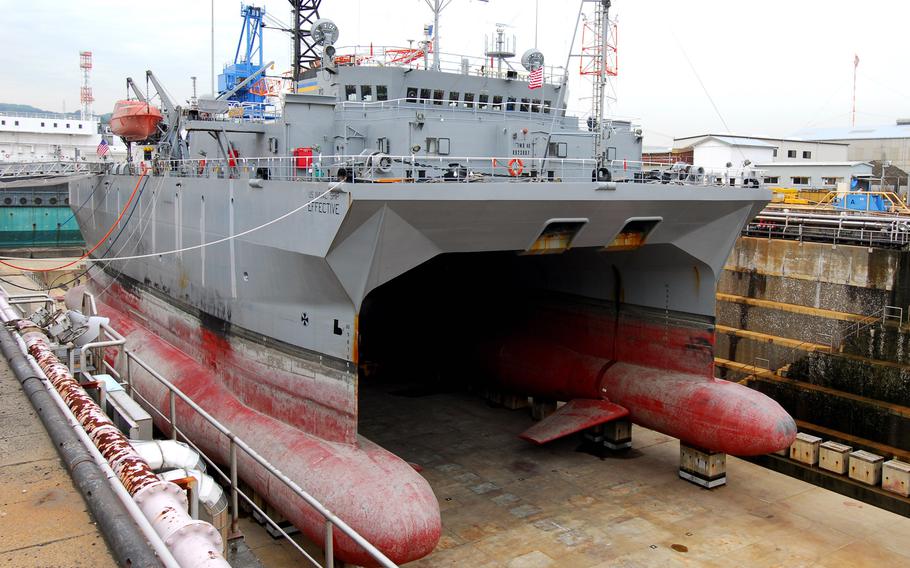.jpg/alternates/LANDSCAPE_910/9099626%201.jpg)
The Arleigh Burke-class, guided-missile destroyer USS Paul Ignatius steams into formation alongside NATO ships on June 5, 2025, in the Baltic region. (Kenneth Lagadi/U.S. Navy)
WASHINGTON — The Navy is relying on the combination of the annual defense budget and supplemental legislation to buy 19 new ships in 2026, an increase from the five ships purchased in 2025 and eight ships purchased in 2024, service officials said.
The purchase of the 19 ships is outlined in the sea service’s budget documents released Thursday. The Navy’s fiscal 2026 budget request for the sea service and the Marine Corps totals $292.2 billion of which $47.3 billion would go to building new ships. In comparison, the Navy spent $28 billion in 2024 and $39 billion in 2025 on shipbuilding.
The Navy’s budget combines a $248.9 billion base spending plan with an additional $43.3 billion from a reconciliation bill moving through Congress that is expected to provide $113.3 billion for the Defense Department’s efforts to bolster shipbuilding, a layered missile defense shield and other defense priorities.
Overall, the Defense Department budget is expected to total $961.6 billion across the Navy, Marine Corps, Army, Air Force and Space Force.
The Navy’s base budget outlines the procurement of three warships, with the separate funds supporting the purchase of 16 additional ships.
“I think for all of us, it is helpful to talk about these together because I think it does confuse the industry when we talk about what is in this bill or that bill. This is our [proposed budget],” a Navy official said Thursday.
Lawmakers in recent weeks have criticized Navy officials for trying to “game the system” by not including large shipbuilding investments in the base budget.

The ocean surveillance ship USNS Effective sits in dry dock at Commander Fleet Activities Yokosuka in Japan in 2007. (Bryan Reckard/U.S. Navy)
Navy Secretary John Phelan told lawmakers that the budget would reflect a commitment to bolstering the shipbuilding industry. Defense officials said Thursday the budget process is taking a “two bills, one budget approach” to fund defense priorities and get them on track.
“We are very confident that our [$961.6 billion] budget in these two lanes will give the department what it needs for the China fight,” a senior defense official said.
The Navy’s base budget will seek one Columbia-class submarine, one Virginia-class submarine and one ocean surveillance ship. An additional Virginia submarine and two surveillance ships would be purchased with reconciliation funds. The reconciliation funds would also purchase two destroyers, one amphibious transport dock and one amphibious assault ship.
The service is also requesting $1.96 billion to purchase nine new medium landing ships used to transport Marines in 2026, an aggressive change to a previous plan to purchase the ships one or two at a time in the next four years. The sea service has pursued the purchase of the new landing ships since at least 2020, but the design plans and growing costs delayed the program in 2024.
The ships are meant to carry small Marine Corps units armed with anti-ship or anti-air missiles, particularly in the western Pacific and for any potential conflict with China, according to a 2020 report from the Congressional Budget Office. Medium landing ships — at 200 to 400 feet in length with a crew of 70 sailors and the ability to support 50 Marines — are smaller and less costly than other Navy amphibious assault and transport dock ships.

Sailors prepare an E-2D Advanced Hawkeye for flight operations on the deck of the aircraft carrier USS Carl Vinson in the U.S. Central Command area of responsibility on June 14, 2025. (U.S. Navy)
Included in the Navy’s base budget is the planned purchase of 43 aircraft, including F-35 fighter jets, E-2D surveillance aircraft, heavy-lift helicopters and unmanned aircraft. Of those, eight F-35 jets, four surveillance planes and three unmanned carrier-based aircraft will go to the Navy, with the rest going to the Marine Corps.
The Navy’s proposed budget also calls for $93.7 billion for maintenance and operations of warships, $29.2 billion for research and development and $7.4 billion for family housing.
“The [Navy’s] budget request for fiscal year 2026 funds a strong, global Navy and Marine Corps that is postured and ready to defend our homeland, deter adversaries, and prevail in war — prioritizing China as our most consequential opponent. It is a thorough, strategy-driven budget that is focused on delivering resources to ensure our naval forces remain ready, resilient, flexible, and agile to execute national tasking and preserve peace through strength,” according to the budget documents.